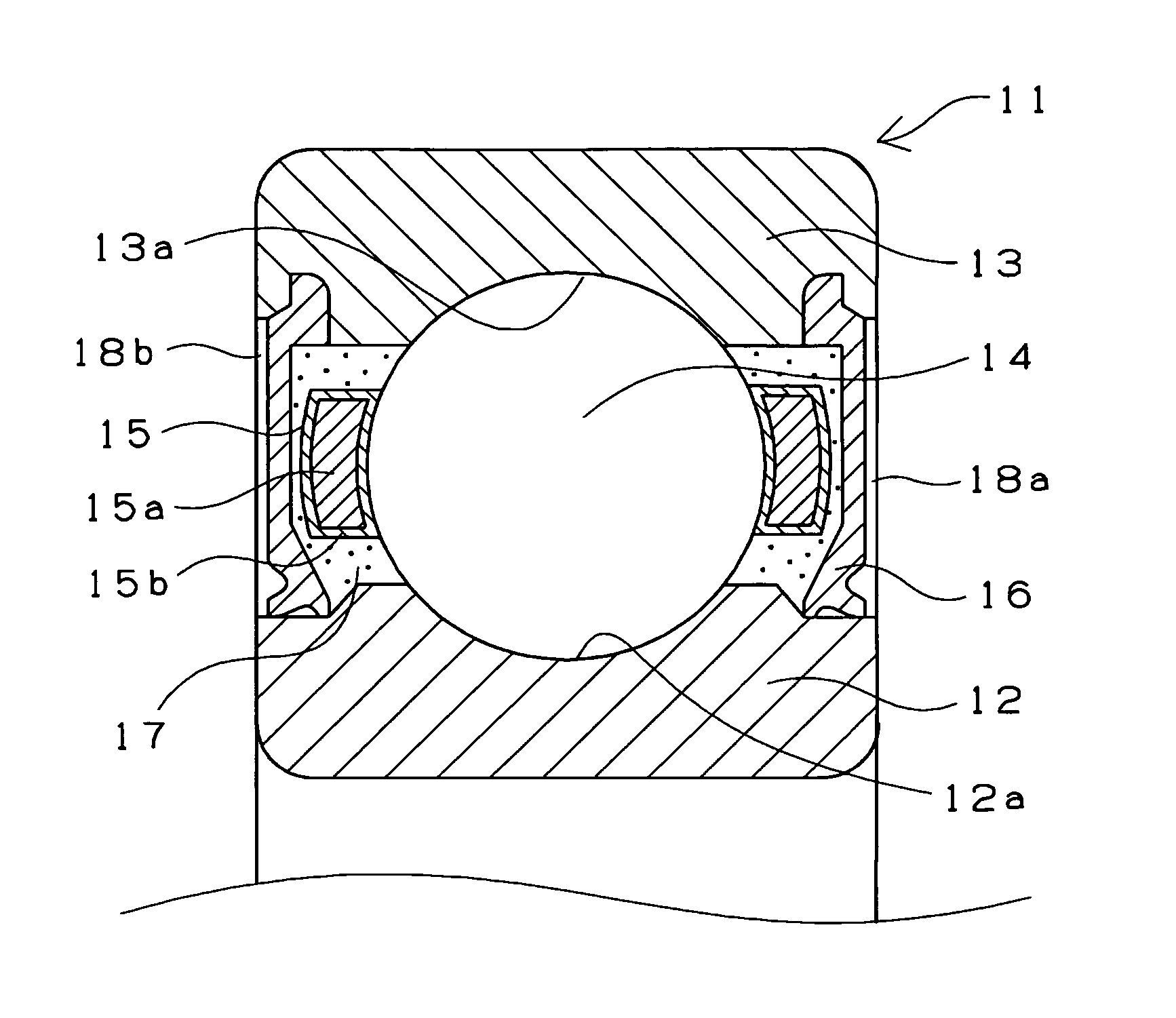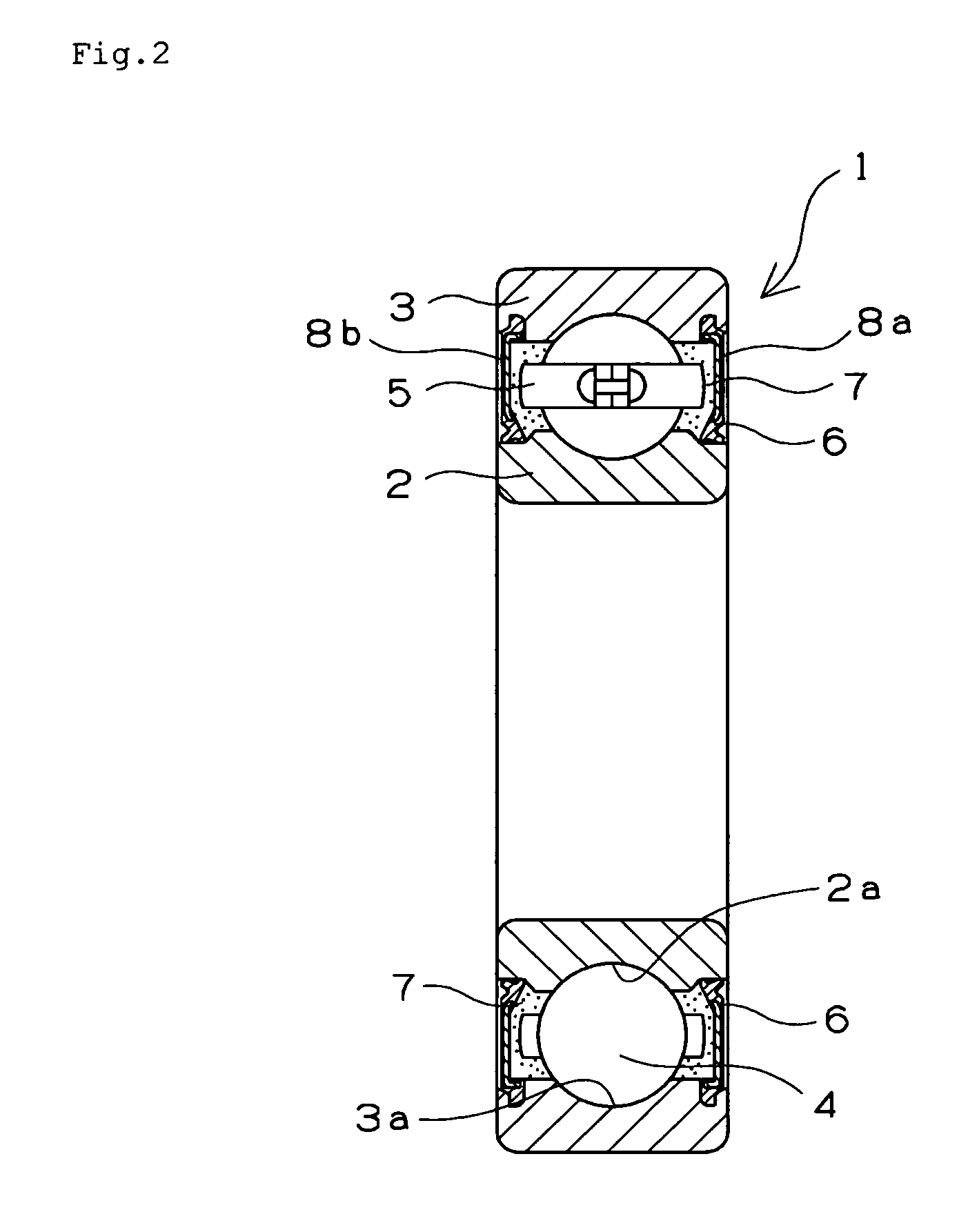Member for rolling bearing and rolling bearing
a technology of rolling bearings and members, applied in the direction of shafts, bearings, rotary machine parts, etc., can solve the problems of increasing and reducing the degree of environmental load, so as to reduce the cost of synthetic resin. , the effect of reducing the amount of environmental load
- Summary
- Abstract
- Description
- Claims
- Application Information
AI Technical Summary
Benefits of technology
Problems solved by technology
Method used
Image
Examples
example 1
[0074]A case in which a polymeric member composed of only a polymer consisting of a raw material derived from a biomass (containing 14C) was used is shown. Thus all carbon elements composing the polymeric component of the polymer are derived from the biomass (bio-carbon degree: 100%). Because the bio-carbon degree is 100%, the amount of carbon dioxide the polymeric component decomposes and generates at the time of disposal of the polymeric member of the example 1 by incineration is substantially zero. Comparing the case in which the polymer of the example 1 was used with a case in which a polymer produced by using a 100% fossil resource raw material was used, the reduction rate of carbon dioxide emission at the time of the disposal of the polymeric member of the example 1 by incineration is 100%. When the polymer of the example 1 is used for the polymeric member for the rolling bearing, the effect of reducing the carbon dioxide emission is conspicuously high.
[0075]As the polymer hav...
example 2
[0076]A case in which a polymeric member composed of a polymer consisting of a raw material (containing 14C), derived from a biomass, which contained 62.5% of all carbon elements composing the polymeric component thereof and a raw material (not containing 14C) derived from a fossil resource, which contained 37.5% of all the carbon elements was used is shown (bio-carbon degree: 62.5%). The amount of the carbon element of the raw material derived from the fossil resource is 37.5%. Thus when the polymeric component completely decomposes at the time of disposal of the polymeric member of the example 2 by incineration, the amount of carbon dioxide generated thereby is 37.5% in comparison with a polymer produced entirely from the raw material derived from the fossil resource. Therefore comparing the case in which the polymer of the example 2 was used with the case in which the polymer produced entirely from the raw material derived from the fossil resource was used, the rate of the carbon...
example 3
[0078]A case in which a polymeric member composed of a polymer consisting of a raw material (containing 14C), derived from a biomass, which contained 50% of all carbon elements composing the polymeric component thereof and a raw material (not containing 14C) derived from a fossil resource, which contained 50% of all the carbon elements was used is shown (bio-carbon degree: 50%). The amount of the carbon element of the raw material derived from the fossil resource is 50%. Thus when the polymeric component completely decomposes at the time of disposal of the polymeric member of the example 3 by incineration, the amount of the carbon dioxide generated thereby is 50% in comparison with a polymer produced entirely from a raw material derived from a fossil resource. Therefore comparing the case in which the polymer of the example 3 was used with the case in which the polymer produced entirely from the raw material derived from the fossil resource was used, the rate of the carbon dioxide e...
PUM
| Property | Measurement | Unit |
|---|---|---|
| aspect ratio | aaaaa | aaaaa |
| thickness | aaaaa | aaaaa |
| thickness | aaaaa | aaaaa |
Abstract
Description
Claims
Application Information
 Login to View More
Login to View More - R&D
- Intellectual Property
- Life Sciences
- Materials
- Tech Scout
- Unparalleled Data Quality
- Higher Quality Content
- 60% Fewer Hallucinations
Browse by: Latest US Patents, China's latest patents, Technical Efficacy Thesaurus, Application Domain, Technology Topic, Popular Technical Reports.
© 2025 PatSnap. All rights reserved.Legal|Privacy policy|Modern Slavery Act Transparency Statement|Sitemap|About US| Contact US: help@patsnap.com



